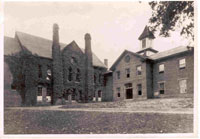Weaver College
 Weaver College, a coeducational Methodist institution, operated in the Buncombe County town of Weaverville from 1873 until 1934. Prior to the establishment of what was originally known as Weaverville College, an academy founded in 1851 by the local Sons of Temperance stood on the site chosen for the campus. Montraville Weaver contributed the land on which the first buildings were situated. Through gifts and purchases, the campus grew to 55 acres. Initially the college was governed by a local board of trustees independent of any denomination. The school's first president was James A. Regan. Only in 1883 was the property deeded to the Methodist Episcopal Church and the school placed under the supervision of the Western North Carolina Conference.
Weaver College, a coeducational Methodist institution, operated in the Buncombe County town of Weaverville from 1873 until 1934. Prior to the establishment of what was originally known as Weaverville College, an academy founded in 1851 by the local Sons of Temperance stood on the site chosen for the campus. Montraville Weaver contributed the land on which the first buildings were situated. Through gifts and purchases, the campus grew to 55 acres. Initially the college was governed by a local board of trustees independent of any denomination. The school's first president was James A. Regan. Only in 1883 was the property deeded to the Methodist Episcopal Church and the school placed under the supervision of the Western North Carolina Conference.
In 1912 the school was renamed Weaver College and changed from four-year to junior college status. Preparatory classes continued to be offered. Student activities revolved around literary societies and the sports programs. Graduates of Weaver include North Carolina chief justice Walter H. Stacy, Congressman Zeb Weaver, and University of North Carolina professor Hugh T. Lefler.
The Western North Carolina Conference decided in 1933 to merge Weaver and Rutherford Colleges to create a single coeducational Methodist junior college on the grounds of the old Brevard Institute. In the fall of 1934, 30 Weaver students and 5 faculty members moved to the new Brevard College. Brevard continues to preserve the earlier institution through the Weaver Room of the library and the Weaver College Bell Tower. In Weaverville two structures remain from the original campus: the 1874 administration building, now used as a Masonic temple, and a dormitory.
References:
William S. Powell, Higher Education in North Carolina (1970).
F. A. Sondley, A History of Buncombe County, North Carolina (1930).
Douglas Swaim, ed., Cabins and Castles: The History and Architecture of Buncombe County, North Carolina (1981).
Additional Resources:
Weaver College, NC Highway Historical Marker P-74: https://www.ncdcr.gov/about/history/division-historical-resources/nc-highway-historical-marker-program/Markers.aspx?ct=ddl&sp=search&k=Markers&sv=P-74%20-%20WEAVER%20COLLEGE
Brevard College Heritage: http://www.brevard.edu/Default.aspx?tabid=236
Weaver College Yearbooks: https://lib.digitalnc.org/search?ln=en&p=691:%22Weaver+College%22%20AND%20655:%22Yearbooks%22&sf=year&so=a
Hugh Lefler, NC Highway Historical Marker M-54: https://www.ncdcr.gov/about/history/division-historical-resources/nc-highway-historical-marker-program/Markers.aspx?sp=search&k=Markers&sv=M-54
Image Credit:
"Skinner Hall on the campus of Weaver College." Image courtesy of Brevard College. Available from https://www.ncdcr.gov/about/history/division-historical-resources/nc-highway-historical-marker-program/Markers.aspx?ct=ddl&sp=search&k=Markers&sv=P-74%20-%20WEAVER%20COLLEGE (accessed November 9, 2012).
1 January 2006 | Hill, Michael